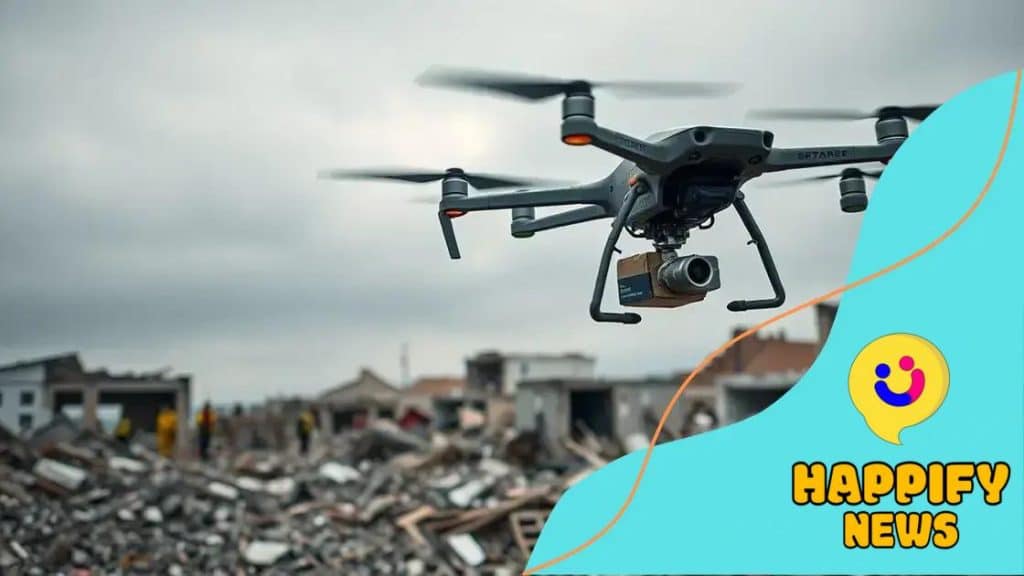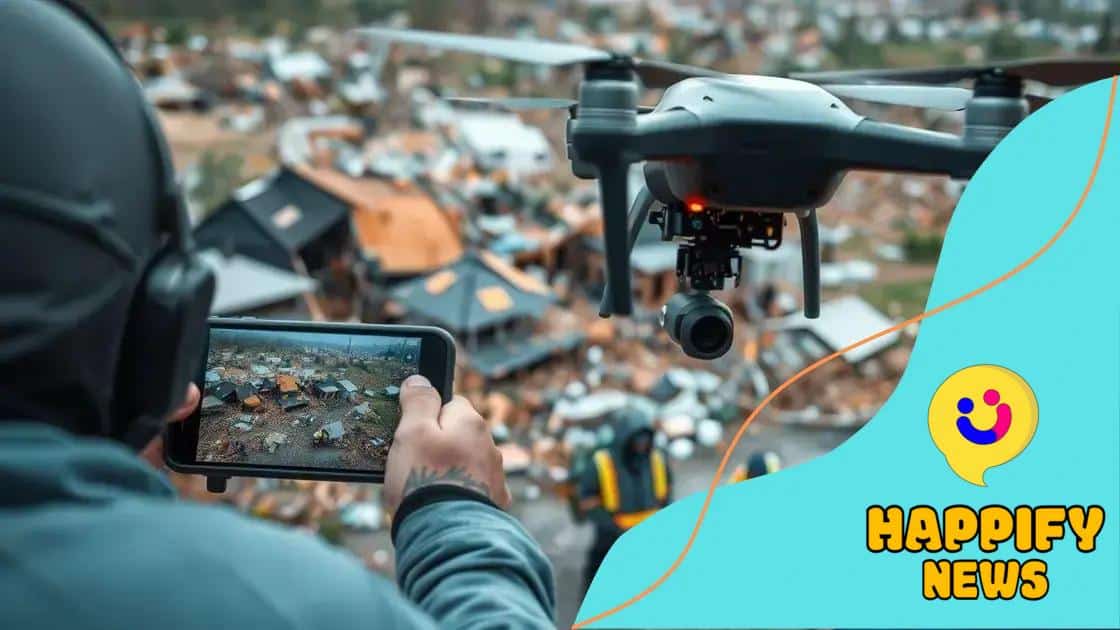Drones in disaster relief: a game changer for aid

Anúncios
Drones in disaster relief enhance emergency response by providing rapid aerial assessments, delivering supplies, and utilizing advanced technology to improve situational awareness and decision-making in critical environments.
Drones in disaster relief have emerged as crucial tools, reshaping how aid is distributed in crisis situations. Have you ever wondered how these flying devices can navigate dangerous terrains to deliver supplies? Let’s dive into their impact.
Anúncios
The role of drones in emergency response
The role of drones in emergency response is becoming increasingly vital as these flying devices offer unique advantages in critical situations. They can reach areas that are difficult or dangerous for humans to access, making them essential tools in various disaster scenarios. Understanding how drones operate can help us appreciate their impact in saving lives.
Rapid Assessment of Disaster Zones
Drones can quickly survey affected areas, providing real-time data for responders. They collect detailed imagery and information, which aids agencies in determining the extent of damage. This speed enables teams to prioritize who needs help most urgently.
- Immediate aerial views of the landscape
- Identification of blocked roads and hazards
- Mapping out safe routes for rescue operations
- Real-time data sharing with ground teams
Using drones also allows responders to be more efficient. Instead of sending teams into potentially unstable areas, drones can take the initial risk, delivering vital information without putting lives in danger. This method saves time and resources.
Anúncios
Search and Rescue Operations
Drones have shown immense capability in search and rescue operations. With thermal imaging cameras, they can detect the heat signatures of individuals, even in low visibility conditions. This capability enhances the chances of locating survivors promptly.
Moreover, drones can drop supplies like food, water, and medical kits to isolated habitats, ensuring that those in need receive care without delay. This feature is particularly crucial during the critical first hours following a disaster.
In addition to locating survivors, drones are also instrumental in supporting emergency workers. They provide ongoing assessments of risky environments, relaying continuous updates that allow rescue teams to make informed decisions. The integration of drones into emergency services is revolutionizing how we respond to crises, making operations faster and safer.
How drones are aiding in search and rescue operations
Drones are transforming search and rescue operations by making them more efficient and effective. In emergency scenarios, time is crucial. Drones can quickly cover vast areas, providing valuable information and improving rescue outcomes.
Advanced Technology in Rescue Missions
The technology behind drones enhances their utility in challenging environments. Many drones are equipped with high-resolution cameras and thermal imaging systems, allowing them to detect even the faintest heat signatures. This feature is especially important when searching for survivors in conditions where visibility is poor.
- Thermal imaging helps locate individuals in dark or obstructed areas.
- Drones can access difficult terrains like mountains or collapsed structures.
- Real-time video feed assists teams in making informed decisions.
- GPS tracking ensures precise location of individuals in distress.
Many rescue teams now utilize multiple drones simultaneously, collaborating to cover more ground. This method not only speeds up the process but also increases the chances of finding survivors alive. With the ability to fly over hazardous areas, drones can assess the situation without risking the lives of rescue workers.
Delivering Supplies to Isolated Areas
During search and rescue missions, delivering supplies can be challenging. Drones can transport medical kits, food, and water directly to people in hard-to-reach locations. This is especially useful in natural disasters where roads may be blocked.
The agility of drones ensures that help arrives quickly. They provide a critical lifeline for those who are stranded or injured, bridging the gap until ground teams can reach them. Integration of drones into these operations is a game changer, allowing for more timely and effective aid.
As drones continue to evolve, their role in search and rescue operations will expand further. Embracing these technologies opens up new possibilities for saving lives and enhancing emergency response capabilities.
Advantages of using drones for disaster assessment

The advantages of using drones for disaster assessment are numerous and play a crucial role in emergency management. These versatile devices provide significant benefits that enhance the efficiency and effectiveness of disaster response efforts.
Speed and Accessibility
Drones can quickly reach disaster zones that may be hazardous or simply unreachable by traditional means. With the ability to cover large areas in a short time, they provide first responders with immediate data.
- Quick aerial surveys reduce assessment time.
- Access to remote locations without putting lives at risk.
- Real-time data collection enhances decision-making.
- Less dependency on vehicular access through damaged infrastructure.
This fast access to critical information allows teams to prioritize their efforts based on the severity of the damage and need for assistance. With drones, agencies can react faster when every second counts.
Detailed Data and Imaging
Utilizing advanced technology, drones are equipped with various sensors and cameras that gather detailed aerial imagery. These visuals help in analyzing the extent of damage more accurately.
The use of high-resolution cameras provides clearer images that assist in documenting the disaster. Furthermore, drones can collect thermal and multispectral data, helping assess conditions that are not visible to the naked eye.
The data acquired can be processed to create 3D models of the affected areas, providing a comprehensive view of the situation. This information is crucial for planning recovery efforts.
Overall, drones streamline the disaster assessment process. By combining speed, accessibility, and detailed data collection, these airborne tools have revolutionized how we evaluate situations following a disaster.
Challenges faced by drone operators in disaster zones
The challenges faced by drone operators in disaster zones can be significant and varied. While drones are powerful tools in emergency response, their effective use depends on overcoming several obstacles. These challenges can impact the speed and efficiency of operations.
Adverse Weather Conditions
Weather can play a major role in the ability of drones to operate effectively. High winds, rain, and low visibility can hinder flight operations, making it impossible to gather needed data.
- Strong gusts can lead to unstable flights.
- Rain or snow can impair camera functionality.
- Poor visibility can complicate navigation.
- Temperature extremes affect battery performance.
These conditions may require operators to put their mission on hold, leading to delays in critical search and rescue operations.
Regulatory and Airspace Restrictions
Drones face strict regulations, especially in disaster zones where airspace might be limited. Operators must navigate airspace restrictions to avoid conflicts with manned aircraft.
Obtaining necessary permissions can take time, delaying important missions. Additionally, operators need to be skilled in understanding and complying with local laws and regulations.
As drones become more widely used, there is hope that policies will evolve to accommodate their capabilities while ensuring safety for all air traffic.
Technical Difficulties and Equipment Limitations
Technical issues can arise with drones, which may lead to operational delays. Equipment failures can prevent drones from completing their missions, and maintaining a fleet of drones is crucial for successful operations.
Battery life is another consideration. Depending on the mission, a drone may not have sufficient battery power to complete its tasks, necessitating strategic planning regarding when and how long to deploy the devices.
Drone operators must also be equipped with the right skills and knowledge to troubleshoot problems that may occur during operations in challenging environments. This expertise is vital to ensure drones are used effectively in disaster response.
Future trends in drone technology for disaster relief
The future trends in drone technology for disaster relief promise to enhance the capabilities of responders significantly. As technology advances, drones are set to play an even larger role in emergency preparedness and response.
Autonomous Drones
A major trend is the development of autonomous drones. These drones can operate without human intervention, following pre-set routes and making real-time decisions based on data they collect. This autonomy allows for less reliance on operators, enabling drones to perform critical missions in complex environments.
- Reduced human risk in dangerous situations.
- Ability to cover larger areas without constant control.
- Enhanced data collection through adaptive learning.
- Improved efficiency in emergency assessments.
This technology can empower drones to navigate autonomously during search and rescue missions, adapting to obstacles and changing conditions efficiently.
Enhanced Payload Capacity
Another trend involves increasing the payload capacity of drones, allowing them to carry more supplies. This improvement means drones can transport larger quantities of food, water, and medical supplies directly to those in need.
A larger payload can make logistics much more manageable, especially in areas that are hard to access due to road blockages or other barriers. The expectation is that future drones will be capable of supporting entire teams with essential resources.
Advanced Sensors and AI Integration
Integrating advanced sensors and artificial intelligence (AI) into drone technology is another promising area. AI can help drones analyze data in real-time, leading to quicker and more informed decision-making on the ground.
Drones equipped with advanced sensors might provide thermal imaging, gas detection, and environmental monitoring immediately following a disaster, offering crucial insights into conditions on the ground.
As these technologies continue to evolve, so too will the effectiveness of drones in disaster response. This evolution signifies a strong potential for enhanced safety and rapid responses in times of crisis.
\n
\n
\n
FAQ – Frequently Asked Questions about Drones in Disaster Relief
How do drones improve disaster response times?
Drones provide quick aerial assessments of disaster zones, significantly reducing the time needed to gather critical data and prioritize rescue efforts.
What types of technology do modern drones use for disaster assessment?
Modern drones are equipped with advanced sensors, high-resolution cameras, and thermal imaging, enabling detailed analysis of disaster areas.
Can drones operate autonomously in disaster situations?
Yes, many future drones are designed to operate autonomously, allowing them to navigate and carry out missions without constant human control.
What are the main challenges drone operators face in disaster zones?
Drone operators face challenges such as adverse weather conditions, regulatory restrictions, technical difficulties, and equipment limitations in disaster zones.






